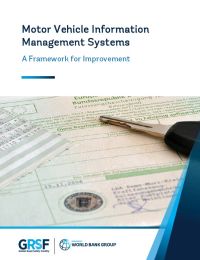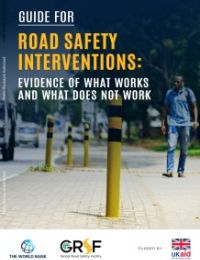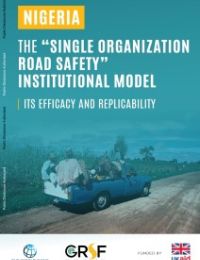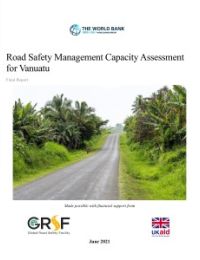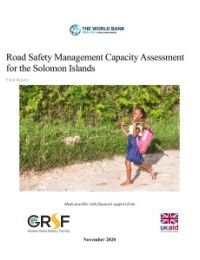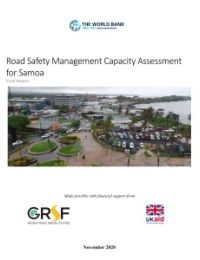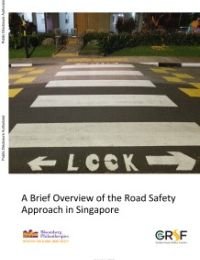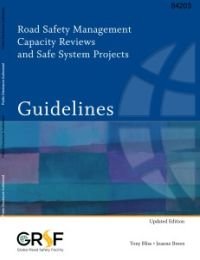Publications
1-9 of 9
-
Road Safety Management
Motor Vehicle Information Management Systems: A Framework for Improvement
March 2025
-
Road Safety Management
Nigeria: The “Single Organization Road Safety” Institutional Model, its Efficacy and Replicability
July 2022
-
What are the strengths and weaknesses of this model and what could be done to improve its’ efficiency and effectiveness?
-
How efficient and effective is the “Single Organizational Model” institutional setup (both federal and state levels) in dealing with the road safety issues in Nigeria?
-
Can this model be replicated in other LMICs and what are the factors that will determine the replicability of the model in those countries?
-
What are the steps in setting up “Single Organizational Model” institutions in LMICs?
-
-
Road Safety Management
Road Safety Management Capacity Assessment for the Solomon Islands
February 2021
-
-
Utilize GRSF recommended methodology to gain a thorough understanding of road safety management capacity;
-
Assess institutional management arrangements as an important focus of the analysis of the road safety system in Samoa;
-
Consider the existing national road safety strategy—Samoa National Action Plan (SNAP) for the Decade of Action for Road Safety 2011-2020—and propose updates for the next period;
-
Provide capacity building on crash investigation and evidence-based road safety measures to ensure success and sustainability, with a focus on vulnerable road users such as females, children, and persons with disabilities; and,
-
Focus on crash data management, including providing hands on capacity building and crash analysis.
-
-
Road Safety Management
Road Safety Management Capacity Reviews and Safe System Projects Guidelines
May 2013
-
Specify a management and investment framework to overcome institutional capacity barriers and support the successful implementation of road safety interventions;
-
Provide practical procedures designed for application at a country level to accelerate knowledge transfer and sustainably scale up investment to improve road safety results;
-
Ensure that institutional strengthening initiatives are properly sequenced and adjusted to the absorptive and learning capacity of the country concerned.

The rapid growth of motorization worldwide has brought both opportunities and challenges, impacting health, resource consumption, and accessibility. Effective management of motor vehicle fleets is crucial for maximizing benefits while minimizing negative consequences. This report presents a framework for improving Motor Vehicle Information Management Systems (MVIMS) to enhance public policy outcomes.
A well-structured MVIMS can support regulatory efforts by improving oversight of used vehicle imports, ensuring compliance with vehicle safety and emissions standards, facilitating periodic inspections, and strengthening vehicle insurance systems. The report highlights key findings from a survey of MVIMS practices in 13 low- and middle-income countries, revealing challenges in data integration, institutional coordination, and information accessibility.
By adopting best practices and strengthening governance, MVIMS can play a critical role in enhancing road safety, environmental sustainability, and transport efficiency. The report outlines a strategic pathway—Assess, Envision, Plan, Implement, and Monitor—to guide countries in developing robust MVIMS that support effective transport management.
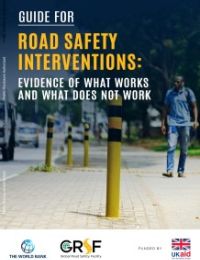
Road traffic crashes result in an estimated 1.35 million deaths and 50 million injuries worldwide per year with over 90 percent of these occurring in Low-Middle Income Countries (LMICs). Aside from the obvious pain and suffering this inflicts on individuals and communities, these deaths and injuries also place a large financial burden particularly on LMICs, by slowing economic growth.
The scale of the current response to this continuing crisis does not match the size of the problem. In addition, limited road safety resources are often expended on ineffective or suboptimal interventions. While road safety knowledge has improved over recent decades, there is still a need to improve decision making when selecting and applying effective evidence-based road safety interventions. Effective interventions are those that reduce fatal and serious injuries.
The World Bank's Global Road Safety Facility (GRSF) has developed this evidence-based guide on “What Works and What Does Not Work” in road safety in response to the critical need for effective evidence-based solutions.
This guide has been prepared to help readers understand that not all road safety interventions are equally effective and that what appear to be “common-sense” approaches to selecting road safety interventions will often not be the best. Although some provide benefits, others have very limited or even negative impacts, despite being commonly—and mistakenly—recommended or accepted. The guide offers a range of recommendations with a focus on interventions in LMICs, although the information may also be of relevance to all countries. The contents will be valuable to those working on road safety at policy or practitioner levels, including World Bank technical team leaders and others who seek to establish, expand, or improve road safety programs in LMICs.
The guide sets knowledge on evidence-based interventions within a “Safe System” context, providing advice on each of the Safe System pillars (road safety management, safe roads, safe speeds, safe vehicles, safe road users, and post-crash care) while recognizing that evidence-based solutions must be drawn from across pillars to produce effective road safety outcomes. At the core of this document is a summary table with an overview of beneficial and non-beneficial interventions based on sound scientific evidence. This is followed by more detailed information including case studies and references to the evidence base to support the summary.
Many safe road interventions are recommended for adoption, including integrated public transport, roadside and central barrier systems, medians, infrastructure to support appropriate operational speed for road users, roundabouts, grade separation and interventions to reduce exposure to risk at intersections, pedestrian footpaths and crossings, separated bicycle and motorcycle facilities, and traffic signs and line marking (including audio-tactile line marking). Some of these are highly effective, with up to a 70 or 80 percent reduction in fatalities and severe injuries (for example, safety barriers and roundabouts).
Various speed-related interventions also produce significant benefits, with some able to almost eliminate death and serious injury. Examples of effective speed interventions include traffic calming (including humps and chicanes), roundabouts, raised intersections and crossings, gateway treatments, lower speed limits (including 30 km/h (20 mph) zones for pedestrians) and speed cameras.
A variety of road user-based interventions have been implemented over many years, with effective examples including extensive supervised on-road practice and/or graduated licensing systems as part of the driver-licensing system, increased age for driving license eligibility, hazard perception training and testing, public education and campaigns as part of an integrated strategy (especially communicating enforcement to increase general deterrence), enforcement, penalties, alcohol interlocks, fatigue and speed monitoring, and increased helmet wearing rates.
Key vehicle-based interventions include applying minimum vehicle safety standards and vehicle ratings (through the Global New Car Assessment Program, or “NCAP”), seat belts, periodic vehicle maintenance, daytime running lights, under-run guards on trucks, Electronic Stability Control, and other advanced vehicle technologies.
Enhanced post-crash care can also produce better road safety outcomes, including systems to improve emergency response time, better emergency care, improved first aid skills for the public, and improved hospital care.
Equally important, the report also identifies clear examples where interventions are not effective. The worst of these are interventions that increase risk. These include increasing travel speed without improving quality of safety infrastructure, most forms of post-license driver and rider education and training, and many (but not all) forms of regular school-based driver education (such as those that seek to increase car-handling skills). The increase in risk is typically because such initiatives increase the level of confidence leading to an increase in risk taking. Other interventions that have no demonstrated safety benefits are to be avoided. These include license schemes through application or payment, training programs or education within schools that aim to improve road safety knowledge (including ad hoc visits by road safety experts or enthusiasts), and education campaigns conducted in isolation.
There are effective alternative interventions for each of these as described within this document, and these should be applied instead. It is extremely important that resources are not wasted on ineffective interventions on behalf of road safety but rather that evidence-based road safety interventions are employed.
There are a variety of documents available on the issue of road safety intervention effectiveness, many of which are referenced here. However, there are some key points of differences and added value in this guide, including a synthesis of the evidence on a broad range of interventions and a contrast between effective and noneffective interventions, allowing readers to compare options. Where noneffective interventions are identified, viable effective interventions are provided thereby supporting decision making. The guide also provides direct advice to those working in LMICs, drawing on key sources of information where this is available. Importantly, concise yet robust evidence is provided across each of the Safe System pillars.
There is a need to continue building the knowledge base on effective road safety interventions, particularly in LMICs where there are a number of gaps in knowledge. The contents of this guide represent a useful, up-to-date summary of current knowledge for application.
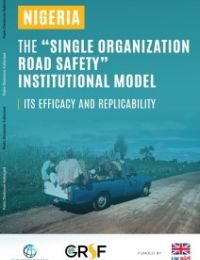
This study is one part of a comprehensive study of lead road safety agencies in low- and middle-income countries (LMICs), which is being conducted on a collaborative basis by the World Bank, the World Health Organization, and the African Development Bank. This particular study is supported by UK Aid through the World Bank’s Global Road Safety Facility (GRSF). It focuses on the case of Nigeria, a federal republic with three tiers of government - federal (central), state and local governments - and its single institutional model for road safety.
This report responds to the following questions:
Download the report to learn more!
RESOURCES ⌵︎
ACKNOWLEDGMENTS ⌵︎
‘The “Single Organization Road Safety” Institutional Model, its Efficacy and Replicability’ Study is supported by UK Aid through GRSF. The Report was written by three main authors: Martin Small, Mustapha Azzouzi and Arpita Roy. The study was led by Farhad Ahmed (Senior Transport Specialist) with support from Md. Towshikur Rahman, who was responsible for the overall coordination.
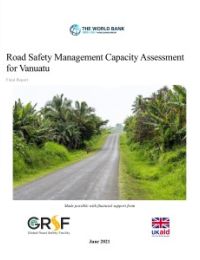
This Road Safety Management Capacity Assessment (RSMCA) seeks to gain a broad understanding of the Government of Vanuatu's road safety management capacity to support its plans to improve road safety outcomes throughout the country. The RSMCA follows the seven critical road safety institutional management functions (Bliss and Breen 2013) to identify key challenges and provide recommendations for improvement in road safety management, and similarly addresses the Safe System pillars for the interventions level. The seven institutional management functions include: results focus, coordination, legislation, finance and resource allocation, promotion and advocacy, monitoring and evaluation, and research and development of knowledge transfer.
The Safe System pillars include road safety management, safe roads and mobility, safe vehicles, safe road users, post-crash care, and safe speeds. The RSMCA’s alignment with both the road safety institutional management functions and the Safe System Approach in turn aims to help the Government of Vanuatu to prioritize targeted next steps to address road crash death and serious injury in the country.

Based on 2018 findings of the World Health Organization (WHO), the number of deaths due to road crashes is 1.35 million deaths per year. While this number is quite high and increasing every year, the rate of road crash deaths per 100,000 of population has remained constant, at around 18 deaths, over the years. This rate of deaths is however not distributed proportionately amongst the different regions and countries. The high-income countries have recorded lowest average rate at 8.3 per 100,000. In contrast to this number, low-income countries have the highest annual road traffic fatality rates averaging at 27.5 deaths per 100,000– more than three times the average for high-income countries.
ROAD CRASH AND IMPACT
Most of the deaths and injuries from road crashes are of the working age population, which negatively impacts both the economy and the demography of the region. Road traffic injuries are currently the 8th leading cause for death for all age groups, and further compounding the demographic impact is the fact that road crashes are the leading cause of death for children and young adults, between the ages of 5 and 29 years.
Road traffic crashes have a high economic impact, costing 3 percent of a country’s GDP on average. They also cause a significant impact on the individuals as well as their families. Injuries arising due to road crashes can lead to trauma for the individual and loss in productivity. Along with costs of treatment, economic challenges may further be increased due to temporary or permanent loss of income as well. Along with the victim, road crashes take an emotional toll on the immediate family members and caregivers during the treatment process or any deaths and add to the economic burden as they may need to take time off work or school to care for the injured.
The distribution of road users varies within different regions and income groups of countries. This impacts the variations in death rates amongst the users. The low- and middle-income countries have a significantly high proportion of pedestrians, cyclists and two- or three-wheeler motorized vehicles. Overall, the global road traffic deaths for pedestrians and cyclists is at 26% and another 28% for two- and three-wheeler motorcyclists, totaling nearly 54% of vulnerable road users. This proportion varies in comparison between the economic group of countries, with a high percentage of road crash victims being car occupants.
Globally, a significant percentage of road crash victims being car occupants is also an indicator of insufficient infrastructure for controlling traffic speeds and volumes. Furthermore, when people use private cars more for their daily activities, it results in a higher level of total vehicle-kilometers traveled (VKT). Choice of using personal vehicle over using non-motorized transport or public mass transport may be attributed to the car-centric planning and design of road infrastructure. Many countries lack adequate protected infrastructure for pedestrians and cyclists. This discourages users to walk or bicycle to their destinations.
Mode-choice plays a critical role in road safety. Public mass transit systems not only provide faster and safer transportation mode choices, they also help reduce dependency on privately owned vehicles on the road. Public mass transit services typically follow designated routes as well, thereby minimizing interferences between different types of road users. While many countries still have to develop mass transit infrastructure such as metro rails, public bus system is quite prevalent, with bus rapid transit (BRT) and bus only lane infrastructures being developed. Absence of proper first and last mile connectivity to the transit stations poses security threats for road users and discourages them from using public transport.
SAFE SYSTEM APPROACH
The Safe System approach derives from the Swedish Vision Zero and Dutch Sustainable Safety strategies that have a long-term goal for a road traffic system to be eventually free from fatalities and serious injuries. It represents a shift away from traditional approach of preventing collisions to a more forgiving approach of preventing fatalities and mitigating serious injuries in road crashes. The traditional approach emphasizes the responsibility of road users to avoid crashes rather than the responsibility of system designers to provide a safe mobility system.
The Safe System approach takes into account that humans are vulnerable and fallible, and errors are to be expected. It aims at ensuring these mistakes do not lead to a crash, and if a crash does occur, it is sufficiently controlled to not cause a death or a life-changing injury. Thereby with a “zero-harm goal”, it places a strong emphasis on road builder/operator and vehicle manufacturer accountability for road safety performance.
The Safe System approach emphasizes shared responsibility. Government agencies at different levels and a range of multisectoral agencies and stakeholders – including policy makers, road engineers, planners, vehicle manufacturers, enforcement officers, emergency medical agencies, road safety educators etc. – are accountable for the system’s safety and all road users – drivers, cyclists, and pedestrians are responsible for complying with the system rules.
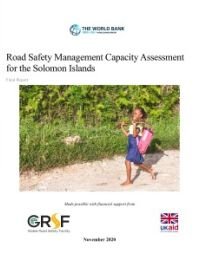
This Road Safety Management Capacity Assessment (RSMCA) seeks to gain a broad understanding of the Solomon Island Government road safety management capacity in order to support the country's development of a national strategy and plan of action to improve road safety outcomes, and subsequently implement those actions effectively.
The RSMCA follows the seven critical road safety institutional management functions (Bliss and Breen 2013) to identify key challenges and provide recommendations for improvement in road safety management, and similarly addresses the Safe System pillars for the interventions level. The seven institutional management functions include: results focus; coordination; legislation; finance and resource allocation; promotion and advocacy; monitoring and evaluation, and research and development of knowledge transfer.
The Safe System pillars include road safety management; safe roads and mobility; safe vehicles; safe road users, post-crash care; and safe speeds. As such, the RSMCA outlines key findings and recommendations relating to both the road safety institutional management functions within the Solomon Islands, and the Safe System Approach, whilst also identifying targeted priority next steps to address road crash death and serious injury in the country.
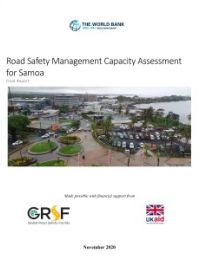
The Road Safety Management Capacity Assessment (RSMCA) is an activity within a broader Advisory Services and Analytics (ASA), which aims to gain a holistic and thorough understanding of the road safety management capacity of three selected Pacific Island Countries (PICs)—Samoa, the Solomon Islands and Vanuatu—in order to support their respective governments to develop national strategies and plans of action to improve road safety outcomes, with a focus on crash data management. The ASA will also support a pilot of the World Bank’s Data for Road Incident Visualization, Evaluation, and Reporting (DRIVER) road crash database in Samoa and provide hands on capacity building in crash analysis.
The ASA is being funded by a Global Road Safety Facility (GRSF) grant from the United Kingdom Agency for International Development (UK AID). The GRSF grant will help the Government of Samoa (GoS) to have a clear image of their road safety situation, risks and challenges, and further on to establish the basis for a national crash database. To ensure sustainability through capacity building and awareness-raising activities, knowledge will be shared with local stakeholders.
The key objectives of this ASA are as follows:
An auxiliary objective is to build capacity to use crash data to identify problems and implement road safety evidence-based measures in Samoa. Furthermore, given the negative impacts of severe weather events on road safety, which will be further exacerbated by climate change, the ASA will help to address the way that road safety is managed in the face of climate change, by training police officers to gain better skills in crash investigation.
The results from the DRIVER pilot in Samoa will be shared with counterparts in selected other PICs, with the aim of scaling up the system across the region. Only with accurate data can road safety be effectively managed and improved, and results measured. In support of this, as of October 2019, the World Bank’s Environmental and Social Framework (World Bank 2019) calls for road safety to be considered on all World Bank-funded projects.
The World Bank is also currently providing assistance to the road sector in Samoa through several projects, including the Samoa Climate Resilient Transport Project (SCRTP), which commenced in 2018. SCRTP will support the GoS to improve the climate resilience of the road network and provide key assistance required to contribute towards effectively managing climate resilient and safe road sector assets. One of the sub-components of SCRTP is dedicated to establishing and operationalizing a database for recording and analyzing road crash data.
The database will combine the existing siloed data, housed in different government agencies, into a single readily accessible platform under the Ministry of Work, Transport and Infrastructure (MWTI). The system will make use of DRIVER, to be piloted through this road safety ASA. SCRTP has other sub-components and activities focused on road safety, such as Road Safety Audits for project roads, a driver licensing training pilot focusing on women, and a road safety engineering technical assistance activity. This GRSF ASA will provide crucial data and insight for the successful delivery of the road safety program under SCRTP, plus other ongoing World Bank-financed projects.
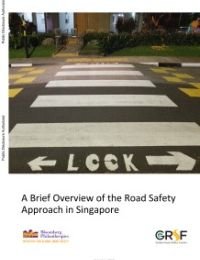
The report introduces how the Safe System Approach works, with a focus on road infrastructure and road safety engineering best practices from one of the best performing countries in Southeast Asia and the Pacific, Singapore.
Singapore roads are not only considered the safest in the region, they rank among the safest globally. Road safety management rules and regulations implemented in the country have resulted in significant strides in managing the effects of collision factors related to roadway design, human behavior, and vehicle attributes. As a result, road safety statistics have shown that fatalities on the Singapore road network have been steadily declining over the past decade. This is leading to a desire on the part of neighboring countries to follow Singapore's example and learn from its experience.
In order to mitigate collisions attributed to vehicle inadequacies or defects, one of the measures taken in Singapore was to enforce a strict vehicle import policy. Vehicle imports are permissible from countries that have adopted and comply with recognized high vehicle safety standards. Vehicle safety compliance is particularly focused on 52 items specified by the Land Transport Authority (LTA). In addition to strict vehicle import standards, Singapore enforces a strict vehicle quota system, which regulates the number of vehicles on the road network. Additionally, vehicles are required to undergo frequent inspections. Cars between 3 and 10 years old are required to have a biennial inspection, and cars older than 10 years are required to undergo annual inspections.
Furthermore, taxis are required to undergo inspections every six months. Road safety education and driver education are core tenants of Singapore's roads safety strategy. Road safety education is predominately undertaken by the Singapore Traffic Police, but nongovernmental organizations such as the National Security Coordination Secretariat contribute significantly to road safety education in Singapore.
Document also available in : Thai, Bahasa (Indonesian), Bahasa (Indonesian), Vietnamese

The Road Safety Management Capacity Reviews and Safe System Projects Guidelines have been designed to assist country road safety professionals, World Bank and regional development bank staff, international consultants, community groups, private sector organizations, and all other global, regional and country partners and stakeholders to conduct capacity reviews and prepare follow-up road safety projects in a variety of low and middle-income countries and investment settings.
The purpose of the Guidelines is to:
The Guidelines emphasize managing for results and the associated strengthening of country road safety management systems, with special attention being paid to the role of the lead road safety agency in ensuring institutional effectiveness and efficiency in program delivery. They highlight the importance of addressing all elements of the road safety management system, taking a staged approach to country road safety investment, and targeting the highest concentrations of deaths and injuries across the road network.
For more information visit this page.
This report is also available in:

